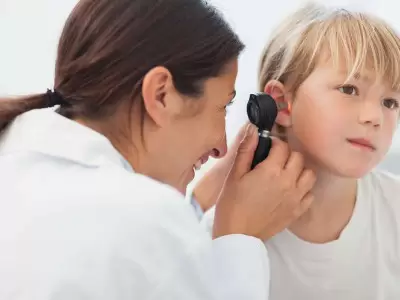Ear Ventilation Tubes
The Eustachian tube, opening to the both sides of the back of the nasal cavities, provides the equalization of the pressure in the middle ear with the pressure of the outer environment and middle ear ventilation.
As a result of functional disorders of the eustachian tube due to various reasons, when the ventilation of the middle air fails the air in the middle ear is absorbed by the mucosa lining the middle ear and mastoid cellules (air cells in the ear bone) and a negative pressure is formed.
Short duration of the functional disorder leads to the accumulation of the fluid which comes from the mucosal soft tissues, in the cavity of the middle ear (serous otitis media) due to the produced negative pressure. If the problem becomes chronic, then the viscosity of the accumulated fluid increases due to increased mucous secretory glands (secretory otitis media). In addition, withdrawal of the tympanum into the middle ear due to negative pressure may result in collapsing of the membrane and adhesion of the eardrum to the auditory bones that are found in the middle ear and to the base of the middle ear (Adhesive otitis).
The conductive hearing loss forming from the beginning of serous otitis especially has a negative effect in the speech and mental development in children during their period of development. If these complications are not noticed in time and corrected, they may lead to permanent hearing loss or severe chronic otitis media.
In order to prevent the formation of negative pressure in the middle ear of the patients who can not yield a positive improvement in the negative pressure formation and fluid accumulation in the middle ear despite medical treatments applied with the appropriate content with the appropriate duration, a temporary hole should be opened in the eardrum surgically and the air should be taken from the external environment. These surgically opened holes usually heal and close within 7-10 days and in cases in which this period is not sufficient for the recovery of the disease in the mucosa, the problem recurs.
In chronic fluid accumulations for more than 3 months and in situations in which the fluid is viscous, a ventilation tube should be placed in the hole that is opened in the eardrum and ventilation should be provided for sufficient time. The collapsing tympanum recovers (in ears without adhesion) and the hearing loss rapidly turns to normal with insertion of ventilation tubes. In addition, removal of the adenoid and (if necessary) tonsils in the same operation has a positive effect for the long term success of the treatment.
The doctor may prefer using tubes that spontaneously drop off, or the ones that stay on the tympanum until removed by the doctor, depending on the season in which the operation is performed, and the properties of the patient, ear and the fluid accumulating in the middle ear.
Application of ventilation tube in the eardrum is performed under general anesthesia for children, with a surgery that lasts for approximately 10 minutes (only for the application of the tube). Tubes that are placed under microscope usually stays for 6-12 months and then drops off spontaneously or are removed by the doctor.
For the removal of the tubes that do not drop off after a period of 4-6 months, generally the end of spring is preferred. After the tubes are removed, the holes in the eardrums usually close within 2-3 weeks and since the infections decrease during the summer, the probability of the recurrence of the disease decreases and the patient’s need for protecting his/her ear is eliminated and therefore, his/her quality of life increases. For patients, whom 6 months period coincide with the end of summer, waiting for the next spring for the removal of the tubes may be preferred.
With these treatments, most of the patients recover completely; recurrent tube applications or permanent tube application may rarely be needed. Especially in children with recurrent serous otitis complaint, allergies and functions of the immune system should be evaluated. In patients whom eustachian function does not recover, tubes have to stay in the eardrum for long years. Different tube types, manufactured for these types of patients are present.
It is alright for children with tubes in their eardrums to go to swimming in the sea if the water is clean and if they do not dive into the sea. Especially in swimming pools or when taking a shower or bath with soapy water, the outer ear canal should be covered with a cotton containing petroleum jelly or an earplug and the water should be prevented from entering the middle ear through the tube. If infection due to water leakage occurs and if efflux is present, then the disease may easily be controlled with appropriate antibiotics given orally and topically (from the ear canal as drops).






Comment
Your Contact Information will not be shared in any way. * Required Fields